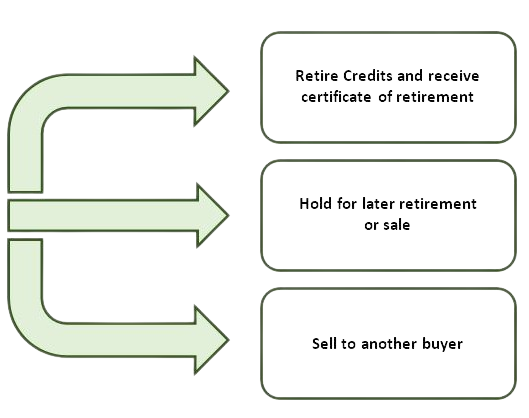PROJECT PLAN
1.1 Confirm the basic project design
1.2 Estimate climate and sustainable development impacts
1.3 Prepare a Key Project Information note summarizing the above
THIRD-PARTY VALIDATION
3.1 Projects must have a positive validation opinion from a VVB (Verification and Validation Body).
3.2 Submit a WB (World Bank) approved Project Design Document (PDD) and all relevant supporting documentation.
THIRD-PARTY VERIFICATION
5.1 Project must provide a fully completed Monitoring Report (MR) and all relevant supporting documentation for WB verification.
5.2 Have a positive verification opinion from the VVB.
PROJECT REGISTRATION
2.1 The project developer should register the project in one of the approved registries.
2.2 Ensure the project methodology aligns with the methodologies approved by the carbon registry.
PROJECT IMPLEMENTATION
4.1 After the Validation process, the project developer should start implementing the project according to the submitted project design document.
CREDITS ISSUANCE
6.1 After the Verification process, the credits will be issued in the registry account.
6.2 The amount of credits issued equals the amount of CO2e reduction. One credit is equivalent to 1 ton of CO2e reduced.
Carbon offsetting requires:
A Reduction Project
The project, which reduces its carbon emissions in a measurable way depending on science based targets & methodologies.
A Carbon Registry:
Carbon Offset Registries are vital in creating a credible offset commodity as they record ownership of credits and track offset projects to issue credits for each unit of emission reduction or removal.
Approved registries by the Financial Regulatory Authority FRA:
Buyers:
Those people or businesses that want to offset their carbon emissions by buying carbon credits and retiring them.
Overview of Trading Process:
How to buy carbon credits
Why offset your carbon footprint?
Businesses:
Why offset your carbon as a business?
Like recycling your waste, reducing your company's carbon footprint won't have much of an international impact on its own, but if every company makes an effort, it will have a significant impact. So with reducing your business’s carbon footprint – if all companies do it, it will make a noticeable impact on global emissions. The idea is to first reduce the business’s carbon footprint as much as possible by doing the obvious things such as reducing energy use through improved energy efficiency, re-cycling and avoiding wastage. Then businesses can further reduce their carbon footprints by buying carbon offsets from an emission-reduction project – this will reduce overall carbon emissions while improving the lives of the project beneficiaries, creating jobs, and alleviating poverty. Therefore, if all businesses reduce their carbon footprint, it will have a significant impact on world emissions. The goal is to first minimize the company's carbon footprint as much as possible by taking simple measures like improving energy efficiency, recycling, and eliminating waste. Then, a company can further lessen its carbon footprint by purchasing carbon credits from a project that reduces emissions; doing so will lower overall carbon emissions while enhancing the lives of project beneficiaries, generating employment, and reducing poverty.
Reasons why your business might want to reduce its carbon footprint further by offsetting
Your business wishes to present a green and sustainability focused image to its customers for public relations or altruistic reasons To satisfy its shareholders or owners In support of its Corporate Social Responsibility commitments To support a project of its choice and help its community To reduce your carbon tax liability To be able to compete with lower-carbon competitors, for instance in the export market Because it makes business sense (green companies have been shown to increase shareholder more than their less-green competitors)
What you will get?
A carbon credit retirement certificate, so your business can legitimately claim footprint reductions for public relations and corporate social responsibility purposes and support its low-carbon status with its customers An active carbon credit that you can resell in the secondary market. Access to the emission reduction projects and their audit reports Possible reduction in your carbon tax liability
Individuals
Reasons to offset your carbon footprint:
You care about the environment and wish to reduce your footprint To support a project of your choice and help its community It is important to your professional image to reduce your emissions As an example to others
What you will get?
A carbon credit retirement certificate as proof of your action Access to the emission reduction projects and their audit reports
Conferences & Events
Why offset your carbon as a conference/event?
Reducing your conference’s carbon footprint is a bit like re-cycling your waste – individually your efforts won’t make much difference globally, but if all conferences make an effort it will make a huge difference. Conference organizers can reduce their carbon footprints by buying carbon offsets from an emission-reduction project – this will reduce overall carbon emissions while improving the lives of the project beneficiaries, creating jobs, and alleviating poverty.
Reasons why you might want to reduce you conference/event’s carbon footprint by offsetting
You wish your conference to present a green and sustainability focused image to its delegates for public relations or altruistic reasons To satisfy your sponsors and attendees In support of its Corporate Social Responsibility commitments To support a project of your choice and help its community To reduce your conference business’s carbon tax liability Because it makes business sense, for instance by attracting more delegates
What you will get?
A carbon credit retirement certificate, so your business can legitimately claim footprint reductions for public relations and corporate social responsibility purposes and support its low-carbon status with its customers Access to the emission reduction projects and their audit reports Possible reduction in its carbon tax liability








